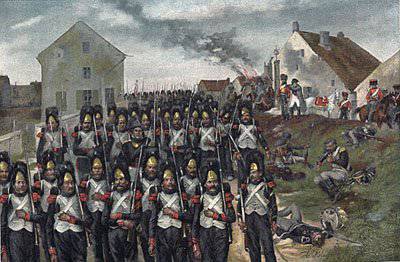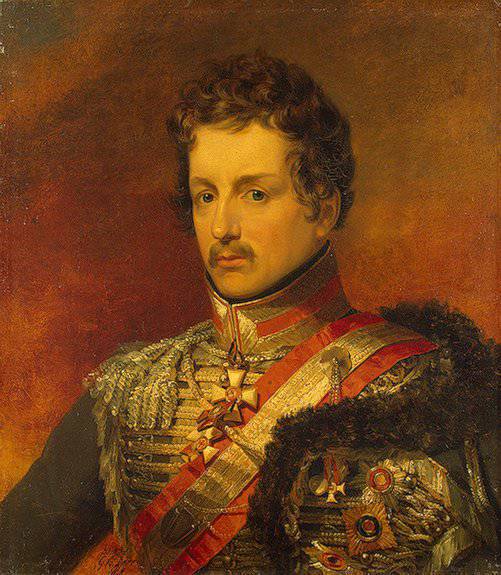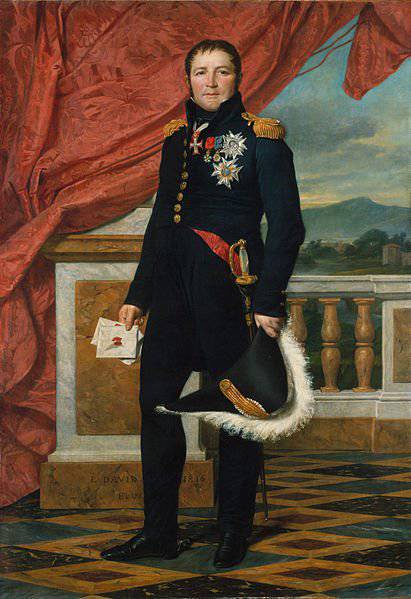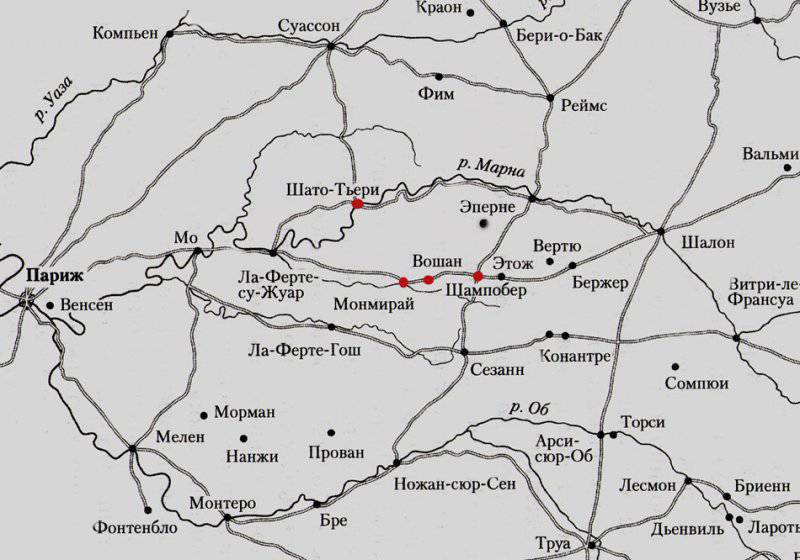Napoleon's offensive against the main allied army. Fighting near Morman and Villeneuve
 Defeating the Silesian Allied Army during the Six Day War on January 29 (February 10) - February 2 (14) on 1814 (Napoleon's Six Day War), the French emperor Napoleon Bonaparte turned his attention to the Allied Main Army, commanded by the Austrian field marshal, Prince Karl Schwarzenberg. The Austrian commander repeated the mistake of Blucher, his corps were scattered at a considerable distance during the slow advance. This allowed Napoleon, quickly redeploying troops to a dangerous direction, to inflict a series of defeats on the units of the Main Army. 17 February was defeated by the Russian avant-garde Palen, and then the Bavarian division. February 18 in the battle of Montro Napoleon defeated the Württemberg corps with two Austrian divisions.
Defeating the Silesian Allied Army during the Six Day War on January 29 (February 10) - February 2 (14) on 1814 (Napoleon's Six Day War), the French emperor Napoleon Bonaparte turned his attention to the Allied Main Army, commanded by the Austrian field marshal, Prince Karl Schwarzenberg. The Austrian commander repeated the mistake of Blucher, his corps were scattered at a considerable distance during the slow advance. This allowed Napoleon, quickly redeploying troops to a dangerous direction, to inflict a series of defeats on the units of the Main Army. 17 February was defeated by the Russian avant-garde Palen, and then the Bavarian division. February 18 in the battle of Montro Napoleon defeated the Württemberg corps with two Austrian divisions.Schwarzenberg was forced to withdraw troops to Troyes, where he joined the army of Blucher. As a result, the first attack of the Allied armies on Paris failed. The Allied Command offered Napoleon a truce, but he refused it, hoping with the help of weapons bargain for more favorable peace conditions for France. This became his strategic mistake. Napoleon lost his last chance to retain power over France.
Location of troops
3 (15) February Napoleon with 12 thousand of selected troops moved from Monmirale to Mo. Initially, he wanted to move to Chalon and inflict another decisive defeat for the army of Blucher, but the threat to the capital forced him to speak out against the army of Schwarzenberg. Napoleon was aware of the indecisiveness of the Austrian commander who followed the instructions of the Vienna court, but he could not completely paralyze the advance of the Main Army. The Russian emperor could order the Russian-Prussian troops, who submitted to him, to make a throw to Paris and decide the outcome of the war with one blow. In Paris, things did not matter. King Joseph wrote to Napoleon about the general discouragement, did not believe in the fighting capacity of the National Guard, complained about the lack of weapons. The troops of Victor and Oudinot retreated and could not stop the Allied forces. In addition, according to Joseph’s report, there was no agreement and trust among the French commanders so that they could successfully repel the assault on Paris. King Joseph and the marshals urged Napoleon to appear in defense of Paris.
It should also be noted that Napoleon overestimated the victories over the corps of Olsufyev, Osten-Sacken, York, Kaptsevich and Kleist during the so-called. The Six Day War. The French emperor decided that he had completely crushed the best army of the enemy. However, the Russian-Prussian corps moved to Chalon and quickly recovered. Army Blucher retained combat capability and was ready for new battles.
At this time, the main army was scattered over a long distance. The vanguard of the corps of Wittgenstein, under the command of Palen, approached Nanji; Wittgenstein's hull arrived in Provins (Provence); the corps of Wrede was at Donnemari, the Württemberg corps was between Bret and Montero (Montro); The 1 and 3 Austrian corps marched along the left bank of the Seine to Fontainebleau. Platov's squad took Nemours. Seslavin squad was to the left, on the road from Montargis to Orleans. The Russian-Prussian reserves were located in the area of Nogent and Troy. As a result of the strong dispersion of troops, the Main Army was poorly prepared for both defense and a decisive offensive. Schwarzenberg hesitated. The allied army was confronted by the French corps under the command of Victor, Oudinot and Macdonald (about 40 thousand people).
Wittgenstein's corps was moved from Provins to Nanji, but received orders from Schwarzenberg to return to Provins. The commander-in-chief was afraid of a detour from the right flank. Count Peter Palen was not warned about this, apparently not expecting a counter-offensive by the enemy. Thus, 4-th. Palen's avant-garde was located 35 versts from Wittgenstein's troops. Closest to Palen, 12 versts, was a small Austrian avant-garde corps, Wrede, under the command of General Gardegg. However, this detachment had an order to retreat when the enemy appeared, without getting involved in a fight, so he could not support the Russian avant-garde.
At this time, Napoleon's troops for a day and a half made a march a throw a distance of 90 versts. The infantry was seated on carts. Napoleon connected with the corps of Victor, Oudinot and Macdonald. The division of Charpentier, individual battalions and cavalry detachments arrived from Paris. Total under the leadership of Napoleon turned around 60 thousand soldiers. He sent 6-th. detachment of General Alix to Fontainebleau and 6-thousand. detachment of General Pajol in the region of Melena. As a result, he left about 47 thousand people.
The defeat of the avant-garde Palen at Morman
4 (16) February, the Russian avant-garde Palen took Morman. From Morman went two large roads: one to Paris, the other to Me. Palen divided the forces and sent the cavalry along two roads. The Chuguev Uhlans and Cossacks of Ilovaisky 12, with the 23-th horse company of Colonel Markov and two foot guns, will move along the Paris road. Grodno and Sumy Hussars, with one Cossack regiment on the road to Mo. Palen had a total of 3 thousand infantry, 1,5 thousand cavalry, with 14 guns.
5 (17) February, the French army launched an offensive. General Alix’s squad drove the vanguard of the Austrian 1 corps out of Fontainebleau. Pazhol's squad set off along the road from Melen to Montero and began a battle with the advanced forces of the Württemberg corps. Napoleon Bonaparte himself moved with the main forces to Morman. Troops of Viktor, Gerard, Milgo and Kellerman's cavalry, all 18 thousand soldiers, were in the forefront.
Noticing the enemy, the French lined up for battle. The troops of Gerard became in the center in the first line, on the flanks of the Duhem and Chateau divisions, on the left wing are the Milga cavalry, on the right - Kellerman. Corps Oudinot and MacDonald, who arrived later, stood in the second line. Guard was in reserve.
Finding superior enemy forces, Palen began to retreat. Artillery and infantry followed the road, followed by a rear guard with two guns, cavalry along the road. Victor's infantry, moving in an accelerated march, overtook Russian troops. At the same time, the French cavalry marched around Morman, aided by the open terrain.
The French cavalry, bypassing Morman, attacked the Russian cavalry and infantry. General Gerard, who was in the head of the column, with one battalion on the move, broke into the village. The infantry of Palen was ousted from the village and continued to retreat, lining up in several squares. The small Russian cavalry, fighting off the oppressive French, retreated several times under the protection of the infantry in order to reorganize.
However, the small troops of Palen could not long resist the enemy. By order of Napoleon, the Guards artillery of Drouot was advanced, which began to smash the Russian orders with grapeshot. The position of the troops of Palena became desperate. Palen several times sent messengers to the Austrian earl Gardeggu, who at that time was located a few miles from the battlefield. But the Austrians refused to come to the aid of the Russian troops, surrounded by the whole French army.
Around Nanji, the army of Palen was finally upset and put to flight. Russian infantry regiments stubbornly resisted and suffered heavy losses. The Selenginsky and Revelsky regiments, who lost 1359 people, suffered especially, they had to be sent for re-formation to Polotsk. Arriving at the battlefield, Wittgenstein and his chief of staff, Dovre, were carried away by the general confusion and were nearly captured. In general, Russian troops lost 2,1 thousand people killed, wounded and captured (according to other sources, 3 thousand people), as well as 10 guns.
The Austrian detachment of Gardegg, who refused to support Palen, despite a quick retreat, was overtaken by the French. The Austrian rear guard, which included the Ulansky regiment of Prince Schwarzenberg and the Hussar regiment of Archduke Ferdinand, was defeated near the Nanzhi forest. The Austrians suffered heavy losses.
On the night of 5 (17) on 6 (18) in February, Wittgenstein withdrew his troops from Proven. The remaining infantry of Palen took Provence, Wittgenstein reinforced their 3-th cuirassier division. A detachment of Colonel Lubomirski, sent to La Ferte-Gaucher, joined the detachment of Lieutenant-General Dibich, who retreated to Cezanne.

Petr Petrovich Palen (1778 — 1864)
The defeat of the Bavarian division at Vilnius
Immediately after the defeat of the Russian avant-garde, Napoleon divided the troops and, without giving them time to rest, sent them from Nanji in three directions, trying to realize a numerical advantage over the scattered forces of the enemy. Napoleon sent Oudinot with the Trellier Division and the 7 Infantry Corps to Nogent against the Wittgenstein Corps. Macdonald with the divisions Pererah and Brish, with the 11 infantry corps, was moving towards Bree against the Wrede corps. Victor and Lerieux Division, 2 Infantry Corps, part of 1 Corps and General Gérard's Paris reserve on the way to Montero against the Württemberg corps. Napoleon himself with a guard, tired of reinforced marches, stopped Nanjee.
Napoleon planned to seize the bridge at Montero, cross over to the left bank of the Seine and cut off Schwarzenberg’s army, followed by the defeat of the allied forces that were closest to Paris. Udino and MacDonald were to divert the attention of the Allied command from the site of the main attack.
It is believed that Napoleon made a mistake when, after the victory at Morman, dispersed his forces. If he had kept the army united, he could have crushed the Bavarian Corps Wrede and the Württemberg corps. By pushing troops in divergent directions, Napoleon weakened the power of the strike and, most importantly, lost the ability to directly control the corps. Napoleon angrily and impatiently hurried the marshals, believing that they could not realize his plans. As one of the French generals noted: “The emperor did not want to understand that not all of his subordinates are Napoleons.”
Oudinot's left column was staying overnight in 10 versts from Nogent. Marshal MacDonald defeated the detachment of Gardegg, captured many prisoners and settled down for the night near Donemari. Victor's right column during the movement collided with the Bavarian brigade under the command of General Habermann, who joined up with Gardegg's detachment.
General Gerard immediately attacked the enemy. Victor sent the cavalry to grip the enemy. The French knocked the Bavarians from the village of Villeneuve. The delay of the French cavalry allowed the Bavarian infantry to retreat and reorganize under the protection of the Austrian lancers and hussars. However, the attack Bordesulya with two squadrons cuirassier, led to the defeat of the Austrian cavalry. The Austrians lost to 500 people.
The commander of the Bavarian division, Lamot (Dela Mott), not hoping to stand against a stronger enemy, built troops in several squares and began to retreat. However, General Gerard again went on the attack and the French, hitting the bayonets, knocked over the Bavarians. Bavarian troops suffered heavy losses. The Bavarian division would be in danger of total annihilation if Viktor supported Gerard with cavalry. However, he already considered the battle completed and did not continue the offensive, placing troops on rest a few kilometers from Montero. Bavarians and Austrians lost in this battle about 2,5 thousand people and a few guns.
Napoleon, having learned about the delay of Victor, became angry and sent him an order at night to immediately advance in any condition of the troops. The French emperor also sent an order to Macdonald and Oudinot to go to Montero, if the crossings in Nogent and Bre remain in the hands of the enemy.

Etienne-Maurice Gerard (1773 — 1852)
Truce offer
Having received the news of the defeat of the avant-garde of Palen, a military council was held at Bra. It was attended by the emperor Alexander, the Prussian king and Prince Schwarzenberg with his headquarters. The Allied Command ordered Wrede and Wittgenstein to retreat beyond the Seine, and the Wuerttembergians to keep a bridgehead on the right bank of the Seine in Montero. Barclay de Tolly had to reinforce Wittgenstein with one grenadier and one cuirassier divisions, and if necessary support Wittgenstein and Wrede. In addition, the Austrians began to withdraw artillery and carts in Troyes.
Schwarzenberg, taking advantage of a convenient moment, decided to fulfill the task of the Vienna Court - to make peace with Napoleon. Alarmed by the success of Napoleon, who won one victory after another, the allies of the Austrians agreed to offer the French a truce. But Napoleon refused Schwarzenberg’s envoy to Count Parr. Earl Parr arrived in Nanji on the night of February with 17 on 18. Napoleon at this time, reassured by his recent victories, canceled the commission given to Kolenkur to make peace on the condition that France maintains its old borders.
In a letter to Knee, Napoleon greatly exaggerated his successes: “I took from 30 to 40 thousands of prisoners; I took 200 guns and a large number of generals, "destroyed many armies, almost without fighting. Yesterday I beat the army of Schwarzenberg and I hope to destroy it before it goes beyond our borders ... ”At the same time, Napoleon expressed his willingness to make peace, but on the basis of the“ natural borders ”of France: the Alps and the Pyrenees. On the truce, he did not agree.
In fact, Napoleon was seized with "dizzy with success." Tearing all the forces, throwing into battle the guards and the bezsykh recruits, Napoleon brilliantly used the mistakes of the enemy, but was doomed. He beat the enemy in just a few passages from Paris. Tactical successes he took for a strategic victory. He repeated the mistakes of 1813 of the year, when his military victories could lead to the conclusion of peace, if Napoleon died of appetites compromised.
The appearance of Count Parro in the headquarters of Napoleon finally clouded the head of a proud commander. He believed that he could not only liberate the territory of France, but even transfer the fighting to the land of the enemy. In Napoleon's envoy, Napoleon saw a sign of despair for the Allies.
On the same day, Napoleon wrote a letter to the Italian Viceroy, in which he complained about the negligence of Victor, who did not allow the Bavarian and Württemberg troops to be completely destroyed. He expressed his contempt for the Austrians, the "bad soldiers" whom he would disperse with one whip. Viceroy Eugene Beauharnais received confirmation of the order to remain in Italy. In addition, Napoleon sent the order Augereau to Lyon. Augereau was to send thousands of soldiers from Spain, conscripts-recruits, troops of the National Guard and gendarmerie with 12 to go on the offensive.
Thus, several victories over the enemy's scattered compounds turned Napoleon's head. He was intoxicated with success and decided that victory over the powerful forces that united almost all the military resources of Europe was near. The hangover will soon come, and it will be very bitter ...
To be continued ...

Information